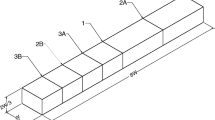Abstract
A comparative assessment has been made of techniques for evaluating residual stress in polymers. Emphasis was placed on the layer removal and hole-drilling methods. A more speculative approach, the chemical probe technique, using the sensitivity of the threshold stress for environment stress cracking to particular chemicals, has been developed to characterize near-surface stresses. Measurements were made for polycarbonate, filled and unfilled acrylo-nitrile butadiene styrene (ABS), and nylon. The materials had been processed by two distinct routes designed to generate different levels of residual stress. The layer removal technique gave the most consistent results for the stress distribution through the thickness but is time-consuming and limited to flat plates. The hole drilling method is potentially more flexible in determining the residual stress in more complex geometries because the measurement is over a small area only. However, although reasonable agreement with the layer removal technique was found for the same principal axis, the values of residual stress calculated for the other principal axis appeared conceptually unreasonable. The chemical probe technique has potential but uncertainty in the quantification of residual stress can arise if significant environment-enhanced relaxation occurs.
Similar content being viewed by others
References
J. R. White, Polymer Testing, 4 (1984) 165.
M. Klarenbeek, C-Mold Ltd., Private Communication, 1998.
C. S. Hindle, J. R. White, D. Dawson and K. Thomas, Polymer Engineering and Science, 32 (1992) 157.
R. G. Treuting and W. T. Read, J. Appl. Phys. 22 (1951) 130.
ASTM E 837–94a, "Determining Residual Stresses in Extruded or Molded Acrylonitrile-Butadiene-Styrene (ABS) Parts by Immersion in Glacial Acetic Acid".
ASTM D 1939–84, "Determining Residual Stresses by the Holedrilling Strain-Gage Method".
A. Turnbull, A. S. Maxwell and S. Pillai, submitted to Polymer Testing, (1998).
"Residual Stress Measurement," TN–503–3,Welwyn Strain Measurement, Measurements Group Inc. (1988).
Rights and permissions
About this article
Cite this article
Turnbull, A., Maxwell, A.S. & Pillai, S. Residual stress in polymers—evaluation of measurement techniques. Journal of Materials Science 34, 451–459 (1999). https://doi.org/10.1023/A:1004574024319
Issue Date:
DOI: https://doi.org/10.1023/A:1004574024319




